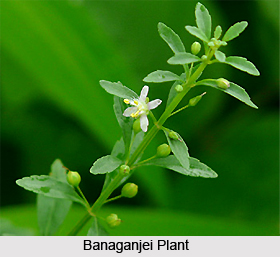 Banaganjei is an erect perennial herb which was introduced into India in the eighteenth century. It is mostly found in West Bengal and Tamil Nadu state at an elevation of about 900 meters. The Botanical name of Banaganjei is Scoparia dulcis. This plant is of great medicinal use and in India it is used for treating bronchitis, cough, kidney complaints, fevers, jaundice, etc. It is known as Mrugandhi gida in Kannada Language.
Banaganjei is an erect perennial herb which was introduced into India in the eighteenth century. It is mostly found in West Bengal and Tamil Nadu state at an elevation of about 900 meters. The Botanical name of Banaganjei is Scoparia dulcis. This plant is of great medicinal use and in India it is used for treating bronchitis, cough, kidney complaints, fevers, jaundice, etc. It is known as Mrugandhi gida in Kannada Language.
Banaganjei is an erect, divaricately branched, fetid-smelling perennial herb which grows up to a height of about 90 centimetres. The stems are 5 to 6-angled and glabrous. Leaves of this medicinal plant of India are opposite or in whorls of three, oblong-ovate to oblanceo-late, 0.5 to 3.8 centimetres long and 0.8 to 1.5 centimetres wide, tapering at base, subacute at apex, margins entire or coarsely crenate-serrate and glabrous on both surfaces. The petioles are up to 0.9 centimetres long. Flowers in this medicinal plant are small, borne in small, axillary whorls on slender pedicels about 8 to 13 millimetres long and the corolla is white in colour and is about 0.5 centimetres in diameter. The fruit (capsule) of Banaganjei is subglobose and it is 3 to 4 millimetres in diameter.
Banaganjei was indigenous to tropical America and the same was introduced to India during the eighteenth century. This plant is commonly found in cultivated fields and roadsides in lowland areas in various parts of the country, especially in the state of West Bengal and Tamil Nadu, at an elevation of about 900 meters in south India.
An infusion of the leaves of Banaganjei is used in the treatment of fever, cough and bronchitis, and as a gargle for toothache. A hot infusion acts as a diuretic and a cold decoction of the plant is used to provide relief from gravel and kidney complaints. An infusion of the leaves, roots and flowering tops is considered useful for treating dysentery and diarrhea. A decoction of the roots and leaves of this medicinal plant is used to relieve fevers. All parts of the plant are used as an emetic. The aqueous extract obtained from the crushed aerial portions of this plant is taken orally in the treatment of spermatorrhoea among the tribal inhabitants of central Orissa. In eastern Bihar, the leaf juice is taken with yoghurt for treating jaundice; this region`s tribal women also use the juice of the plant to test for pregnancy, and when mixed with urine, a colour change is considered a positive indicator. The fresh stems and leaves contain an antidiabetic compound (amellin) which gives relief from the symptoms of glycosuria, reduces hypergly-caemia, increases red blood cell count, and is useful for relieving several complications linked with diabetes mellitus. Amellin reportedly reduces both urine and blood sugar level more gradually than that of insulin.



















